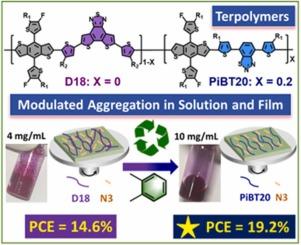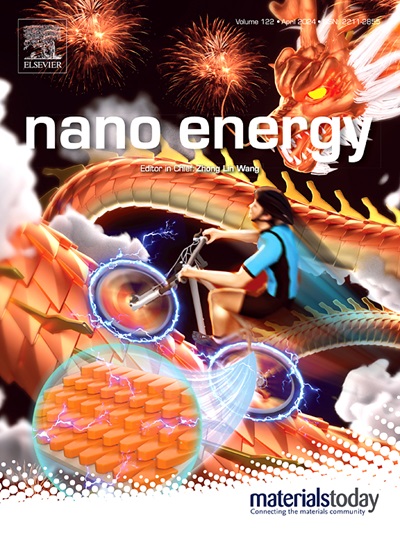Modulated aggregation on terpolymer towards 19.2 % green solvent processed binary organic solar cells
IF 17.1
1区 材料科学
Q1 CHEMISTRY, PHYSICAL
引用次数: 0
Abstract
Organic solar cells (OSCs) with efficiencies over 20 % demonstrate significant potential in the photovoltaic market. However, the fabrication of state-of-the-art OSCs often relies on the use of highly toxic solvents. To advance OSCs toward industrial production, it is crucial to develop efficient and environmentally friendly solvent-processed OSCs. In this contribution, 1,2,3-benzothiadiazole is used as a third monomer to modify the benchmark donor D18, affording three terpolymers: PiBTX (X = 10, 20, 30). Thanks to the steric hindrance introduced by 1,2,3-benzothiadiazole, the PiBTX terpolymers exhibit good solubility in the non-halogenated solvent o-xylene and high luminous efficiency. Moreover, the PiBTX terpolymers enable the modulation of multiple properties, including reduced HOMO energy levels, increased J-aggregation in both solution and film, and improved miscibility with the acceptor. Hence, the terpolymers PiBTX outperform D18 in o-xylene-processed OSCs. Notably, owing to efficient charge generation, transport, and extraction, leading to higher JSC and FF, as well as the lower-lying HOMO energy level and potential Förster resonance energy transfer that reduce non-radiative recombination loss, the PiBT20 terpolymer achieves an impressive efficiency of 19.2 %, ranking among the highest for OSCs processed with green solvents. This work offers a robust strategy for designing efficient polymer donors that are compatible with green solvents.

三元共聚物在19.2%绿色溶剂制二元有机太阳能电池上的调制聚集
效率超过 20% 的有机太阳能电池(OSC)在光伏市场上展现出巨大的潜力。然而,最先进的有机太阳能电池的制造往往依赖于剧毒溶剂的使用。为了推动 OSC 走向工业化生产,开发高效、环保的溶剂处理 OSC 至关重要。在本文中,1,2,3-苯并噻二唑被用作第三种单体来修饰基准供体 D18,从而产生了三种三元共聚物:PiBTX(X = 10、20、30)。由于 1,2,3-苯并噻二唑带来的立体阻碍,PiBTX 三元共聚物在非卤代溶剂邻二甲苯中具有良好的溶解性和较高的发光效率。此外,PiBTX 三元共聚物还能调节多种特性,包括降低 HOMO 能级、增加溶液和薄膜中的 J 聚集以及改善与受体的混溶性。因此,在邻二甲苯加工的 OSC 中,PiBTX 三元共聚物的性能优于 D18。值得注意的是,由于高效的电荷生成、传输和萃取,导致更高的 JSC 和 FF,以及较低的 HOMO 能级和潜在的佛斯特共振能量转移,减少了非辐射重组损耗,PiBT20 三元共聚物实现了 19.2% 的惊人效率,在使用绿色溶剂加工的 OSC 中名列前茅。这项工作为设计与绿色溶剂兼容的高效聚合物供体提供了一种稳健的策略。
本文章由计算机程序翻译,如有差异,请以英文原文为准。
求助全文
约1分钟内获得全文
求助全文
来源期刊

Nano Energy
CHEMISTRY, PHYSICAL-NANOSCIENCE & NANOTECHNOLOGY
CiteScore
30.30
自引率
7.40%
发文量
1207
审稿时长
23 days
期刊介绍:
Nano Energy is a multidisciplinary, rapid-publication forum of original peer-reviewed contributions on the science and engineering of nanomaterials and nanodevices used in all forms of energy harvesting, conversion, storage, utilization and policy. Through its mixture of articles, reviews, communications, research news, and information on key developments, Nano Energy provides a comprehensive coverage of this exciting and dynamic field which joins nanoscience and nanotechnology with energy science. The journal is relevant to all those who are interested in nanomaterials solutions to the energy problem.
Nano Energy publishes original experimental and theoretical research on all aspects of energy-related research which utilizes nanomaterials and nanotechnology. Manuscripts of four types are considered: review articles which inform readers of the latest research and advances in energy science; rapid communications which feature exciting research breakthroughs in the field; full-length articles which report comprehensive research developments; and news and opinions which comment on topical issues or express views on the developments in related fields.
 求助内容:
求助内容: 应助结果提醒方式:
应助结果提醒方式:


